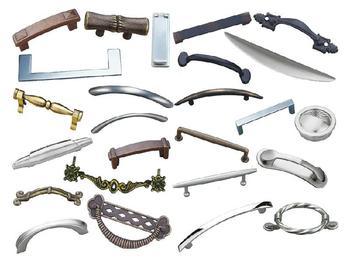 As industrial technology continues to evolve, furniture hardware accessories have transitioned from traditional craftsmanship to mechanical mass production. This shift has raised the bar for versatility, interchangeability, functionality, and aesthetics in hardware design. With the increasing diversity of materials, structural innovations, and functional demands, the role of furniture hardware has expanded far beyond simple connections or moving parts. Today, these components are essential in enhancing both the performance and visual appeal of modern furniture.
This evolution has made furniture hardware an increasingly critical element in the manufacturing process. It plays a vital role in boosting production efficiency, reducing costs, improving product quality, and strengthening market competitiveness—both domestically and internationally. As a result, hardware has become a key differentiator that can significantly impact a company’s profitability and brand reputation.
The global market for furniture hardware is highly competitive and diverse. Leading manufacturers across the world continuously invest in innovative designs, pushing the boundaries of what hardware can achieve. Renowned foreign brands like HAFELE, Hettich, BLUM, and Ferrari not only set trends but also bring advanced, user-friendly features to the table. In an era where product homogenization is common, these companies leverage cutting-edge technology to create more personalized and stylish solutions, aligning with changing furniture aesthetics.
In China, while there are hundreds of furniture hardware brands, only a few have built a solid reputation. Most domestic products struggle to compete at the high-end level, with over 90% of luxury furniture using imported hardware. This trend highlights the gap between Chinese and international standards. Even large domestic furniture companies often rely on foreign hardware to meet market expectations and gain a competitive edge. For smaller manufacturers, adopting foreign hardware is a quick way to enhance product quality and consumer trust.
The design phase of China's furniture hardware industry is gradually gaining momentum. However, it remains a major challenge. Experts have pointed out that Chinese furniture design suffers from issues such as lack of originality, excessive imitation, and limited individuality. These same problems persist in the hardware sector, where innovation and branding lag behind global leaders.
To address these challenges, Chinese enterprises must recognize that their design capabilities, manufacturing techniques, and management systems still need significant improvement. With the increased competition following China’s WTO accession, the industry must adopt advanced technologies and efficient management practices to elevate its standards and move toward a more sustainable and competitive future.
Modern furniture hardware is also evolving with a stronger focus on user experience. New, advanced, and removable hardware solutions are becoming popular, offering greater flexibility and functionality. The continuous development of new hardware not only improves performance and aesthetics but also drives the evolution of furniture design and structure. Standardization efforts, such as the 32mm system, have streamlined production processes, making furniture components more interchangeable and easier to assemble. This standardization enhances the versatility and practicality of hardware, contributing to more efficient and consistent manufacturing outcomes.
As industrial technology continues to evolve, furniture hardware accessories have transitioned from traditional craftsmanship to mechanical mass production. This shift has raised the bar for versatility, interchangeability, functionality, and aesthetics in hardware design. With the increasing diversity of materials, structural innovations, and functional demands, the role of furniture hardware has expanded far beyond simple connections or moving parts. Today, these components are essential in enhancing both the performance and visual appeal of modern furniture.
This evolution has made furniture hardware an increasingly critical element in the manufacturing process. It plays a vital role in boosting production efficiency, reducing costs, improving product quality, and strengthening market competitiveness—both domestically and internationally. As a result, hardware has become a key differentiator that can significantly impact a company’s profitability and brand reputation.
The global market for furniture hardware is highly competitive and diverse. Leading manufacturers across the world continuously invest in innovative designs, pushing the boundaries of what hardware can achieve. Renowned foreign brands like HAFELE, Hettich, BLUM, and Ferrari not only set trends but also bring advanced, user-friendly features to the table. In an era where product homogenization is common, these companies leverage cutting-edge technology to create more personalized and stylish solutions, aligning with changing furniture aesthetics.
In China, while there are hundreds of furniture hardware brands, only a few have built a solid reputation. Most domestic products struggle to compete at the high-end level, with over 90% of luxury furniture using imported hardware. This trend highlights the gap between Chinese and international standards. Even large domestic furniture companies often rely on foreign hardware to meet market expectations and gain a competitive edge. For smaller manufacturers, adopting foreign hardware is a quick way to enhance product quality and consumer trust.
The design phase of China's furniture hardware industry is gradually gaining momentum. However, it remains a major challenge. Experts have pointed out that Chinese furniture design suffers from issues such as lack of originality, excessive imitation, and limited individuality. These same problems persist in the hardware sector, where innovation and branding lag behind global leaders.
To address these challenges, Chinese enterprises must recognize that their design capabilities, manufacturing techniques, and management systems still need significant improvement. With the increased competition following China’s WTO accession, the industry must adopt advanced technologies and efficient management practices to elevate its standards and move toward a more sustainable and competitive future.
Modern furniture hardware is also evolving with a stronger focus on user experience. New, advanced, and removable hardware solutions are becoming popular, offering greater flexibility and functionality. The continuous development of new hardware not only improves performance and aesthetics but also drives the evolution of furniture design and structure. Standardization efforts, such as the 32mm system, have streamlined production processes, making furniture components more interchangeable and easier to assemble. This standardization enhances the versatility and practicality of hardware, contributing to more efficient and consistent manufacturing outcomes.Wood Composite Wall Cladding,Composite Wood Exterior Cladding,Composite Wood Wall Panels,Composite Wood Panels Exterior
Jinhu Jusheng Plastic Wood New Material Co.,Ltd , https://www.goldenlakewpc.com
